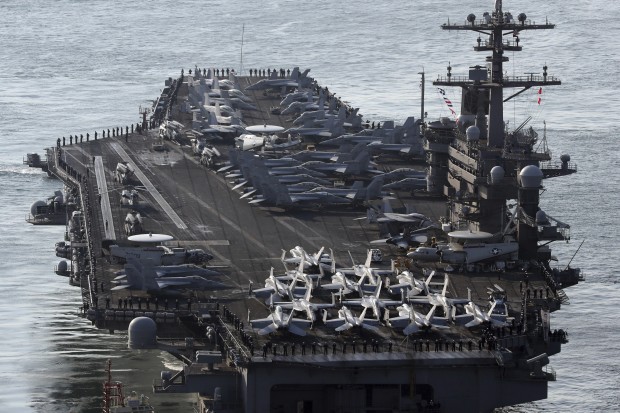Trump seeks options for eliminating North Korea nuke threat

In this March 15, 2017, file photo, the aircraft carrier USS Carl Vinson prepares to participate in the annual joint military exercise called Foal Eagle between South Korea and the United States, at Busan port in Busan, South Korea. The Pentagon says a Navy carrier strike group is moving toward the western Pacific Ocean to provide a physical presence near the Korean Peninsula. North Korea’s recent ballistic missile tests and continued pursuit of a nuclear program have raised tensions in the region, where U.S. Navy ships are a common presence and serve in part as a show of force. The U.S. Pacific Command directed the carrier group, that includes USS Carl Vinson, to sail north to the western Pacific after departing Singapore on Saturday, April 8, according to a Navy news release. AP
WASHINGTON, United States — As a US strike group led by an aircraft carrier steamed toward the Korean peninsula Sunday, a senior official said President Donald Trump has asked to be provided with a range of options for eliminating the North Korean nuclear threat.
The US naval move will certainly raise tensions in the region and comes hard on the heels of a US cruise missile strike on Syria that was widely interpreted as putting Pyongyang on warning over its refusal to abandon its nuclear ambitions.
North Korea denounced Thursday’s attack as an act of “intolerable aggression” and one that justified “a million times over” the North’s push toward a credible nuclear deterrent.
READ: US carrier strike group heads toward Korean Peninsula — official
Secretary of State Rex Tillerson insisted in an interview broadcast Sunday that the United States does not intend to try to remove the regime of Kim Jong-Un.
“That is not our objective and so the whole reasons underlying the development of a nuclear program in North Korea are simply not credible,” Tillerson told the ABC program “This Week.”
He said the United States expects China, the main ally of North Korea, to do more to rein in the regime in Pyongyang.
“They have indicated that they will, and I think we need to allow them time to take actions,” Tillerson said.
US National Security Adviser H.R. McMaster insisted, however, that in the meantime it is “prudent” to send the strike group to the Korean peninsula, criticizing North Korea as a rogue, nuclear-armed nation engaged in provocative behavior.
“Presidents before and President Trump agreed that that is unacceptable, that what must happen is the denuclearization of the peninsula,” McMaster told Fox News.
“The president has asked them to be prepared to give us a full range of options to remove that threat,” he added, apparently referring to Trump’s advisers.
Pyongyang is on a quest to develop a long-range missile capable of hitting the US mainland with a nuclear warhead, and has so far staged five nuclear tests, two of them last year.
READ: US strikes on Syria justify nukes — North Korea state media
Expert satellite imagery analysis suggests the North could well be preparing for a sixth, with US intelligence officials warning that Pyongyang could be less than two years away from developing the means to deliver a nuclear warhead to the continental United States.
North Korea on Wednesday fired a medium-range ballistic missile into the Sea of Japan ahead of a US-China summit.
The isolated North is barred under UN resolutions from any use of ballistic missile technology.
In February, the North simultaneously fired four ballistic missiles off its east coast, three of which fell provocatively close to Japan, in what it said was a drill for an attack on US bases in the neighboring Asian country.
Last August, Pyongyang also successfully test-fired a submarine-launched ballistic missile (SLBM) 500 kilometers (300 miles) towards Japan, far exceeding any previous sub-launched tests, in what Kim hailed as the “greatest success.”
A nuclear-capable SLBM system would take the North’s threat to a new level, allowing deployment far beyond the Korean peninsula and a “second-strike” capability in the event of an attack on its military bases.
Asked if the development of a long-range ballistic missile would mark a red line for Trump, Tillerson said: “If we judge that they have perfected that type of delivery system, then that becomes a very serious stage of their further development.”
US unilateral action?
The White House said Trump spoke Saturday with Japanese Prime Minister Shinzo Abe about the US cruise missile attack on an airbase in Syria and agreed to cooperate more on regional issues including the North Korea nuclear threat.
On Thursday and Friday, Trump hosted his Chinese counterpart Xi Jinping for talks during which he pressed Pyongyang’s key ally to help curb the North’s nuclear weapons program.
Trump has threatened unilateral action against the reclusive communist state, a threat that appeared more palpable after Thursday’s strike on a Syrian airfield following an apparent chemical attack.
The head of the North American Aerospace Defense Command, or NORAD, which provides missile detection for the region, said Thursday she was “extremely confident” of US capability to intercept a potential intercontinental ballistic missile (ICBM) bound for America from the North.
But General Lori Robinson expressed concerns for the type of ballistic missile powered by a solid-fuel engine that Pyongyang said it successfully tested in February.
“Amidst an unprecedented pace of North Korean strategic weapons testing, our ability to provide actionable warning continues to diminish,” Robinson said in written testimony to senators.
And while a US unilateral strike on North Korea from a shorter range might be more militarily effective, it likely would endanger many civilians in South Korea, experts warn. CBB














